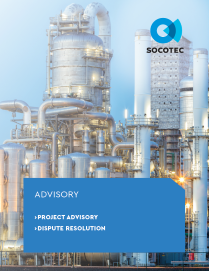Need some advice?
Leave your details and we will get in touch.
Contact an expertConstruction projects are complex ecosystems, fast-moving, high-pressure, and often unpredictable. As scopes evolve, field conditions change, and timelines tighten, even the most well-planned projects encounter friction. But conflict doesn’t have to derail progress. In fact, when managed proactively, friction can become an opportunity for clarity, collaboration, and ultimately better outcomes.
At SOCOTEC, our advisors and forensic specialists frequently support clients, contractors, and legal teams navigating disputes, claims, and performance challenges. Through this work, one message is clear: Relationships and documentation are two of the most powerful tools to reduce conflict and improve project results.
Construction projects succeed when teams communicate, collaborate, and trust one another, especially when issues arise.
Strong relationships create:
Repeat Work & Better Outcomes - Designers, owners, and builders often work together across multiple projects. Investing in trust early encourages alignment and reduces adversarial behavior.
More Efficient Problem-Solving - When stakeholders work as a team, changes are addressed faster and with less friction—reducing downtime, miscommunication, and unnecessary costs.

Claims and litigation come with steep financial and operational consequences:
Hundreds of thousands to millions in legal and consulting costs
Months or years of project disruption and lost productivity
Damage to business relationships and reputations
Delayed project delivery and increased total installed cost
Most disputes are preventable. Early involvement of dispute-resolution experts, advisors, and forensic analysts can identify risk trends like scope creep, scheduling pressure, inadequate documentation, or coordination gaps before they become costly claims.
Unintentional actions or inaction that alter contract expectations.
Small changes that collectively disrupt productivity.
Unforeseen conditions
Document inconsistencies
Market volatility
Regulation updates
Material availability
Weather or force majeure events
Knowing the contract requirements
Clear communication
Timely documentation
Strong QA/QC
Proactive mitigation rather than reaction

When challenges and the risk of claims tend to surface:



Separating the people from the problem
Avoiding blame and focusing on facts
Identifying shared goals
Recognizing each party’s contributions
Prioritizing solutions over accusations
Finding creative options, not zero-sum outcomes
These principles reduce tension and create a path toward resolution that keeps the project moving.
Separating the people from the problem
Avoiding blame and focusing on facts
Identifying shared goals
Recognizing each party’s contributions
Prioritizing solutions over accusations
Finding creative options, not zero-sum outcomes
These principles reduce tension and create a path toward resolution that keeps the project moving.
Trust isn't built on good intentions—it’s built on clarity, consistency, and shared information. A high level of transparency helps teams resolve conflicts early and creates a defensible record if a claim becomes unavoidable.
Transparent documentation practices include:
Diligent daily reporting
Organized change order and RFI logs
Clear written notices (dates discovered, notices sent, authorizations received)
Accessible project management platforms
Open sharing of evolving information
High-value documentation includes:
Schedules (in native format)
Daily/weekly/monthly reports
Timesheets & equipment logs
Photos, videos, and time-lapse footage
Correspondence and meeting minutes
Subcontractor invoices
RFI/CO/CCD logs
Modern claims rely heavily on contemporaneous records. These materials help quantify delays, productivity impacts, cost deviations, and cause-and-effect relationships.
Poor documentation, by contrast, can dramatically weaken a claim, create exposure, and increase legal costs.
Across the industry, collaboration, not conflict, is becoming the driving force behind successful project delivery. Negotiated contracts, early contractor involvement, enhanced commissioning, comprehensive programming, constructability reviews, pre-bid and pre-construction conferences, and cloud-based project management tools are helping reduce ambiguity and align teams around shared objectives. These practices create a more transparent, proactive environment that strengthens relationships and improves project outcomes.
The construction industry continues to evolve toward transparency, partnership, and early risk management. When project teams strengthen relationships and embrace robust documentation, they not only minimize disputes—they deliver higher-quality projects, protect their businesses, and build trust that lasts long beyond project closeout.
SOCOTEC stands ready to support owners, contractors, subcontractors, designers, and legal counsel through advisory services, forensic analysis, claims support, and proactive project controls. Whether you’re seeking to prevent claims or resolve them efficiently, our experts help bridge the gap from conflict to collaboration.

Contact our experts to discover strategies for effective change management.


Get the latest updates about SOCOTEC, subscribe to our newsletter!